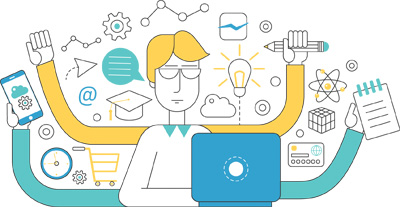Everyone’s heard the saying, “Reduce, Reuse, Recycle.” Yet the two most beneficial options, “reduce” and “reuse,” are often ignored. Why is that? Partly because recycling is an easy and well-defined practice that makes people feel good about their green efforts, partly because the government likes simple methods of showing some environmental progress (for instance, a percentage of material diverted from landfills), and partly because there’s a substantial financial benefit for companies to use recycled material (like aluminum) instead of refining and shipping pure aluminum ore from Australia or Jamaica.
The average American produces 4.5 pounds of waste per day, and Californian’s have hit a staggering 14 pounds of waste per day, so there’s no doubt that reducing your waste by recycling is good for the environment. But did you know that reuse is roughly 93 percent more efficient than recycling? Selling or donating an old computer is much more environmentally friendly than having it shredded for recyclable scraps. Of course, reducing your consumption by not purchasing a computer in the first place is ideal, but it’s not easy to post your hand-written hieroglyphics on MySpace.com.
So, what are the most viable green solutions for businesses that must get rid of unwanted furniture and equipment or that need to regularly upgrade their assets to compete in an ever-evolving economy?
iReuse has developed multiple systems for reuse in partnership with environmentally conscious corporate clients like Autodesk, Birkenstock, PG&E and Charles Schwab, as well as local government, waste management companies and the EPA to ensure that a systematic reuse program is not only beneficial to the environment, but also to the accounting department.
First, if you must consume, consume wisely. You’d be amazed at the high-quality furniture that corporations right in your area no longer need, which you can acquire at deep discounts. This will not only lower your procurement costs, it will also reduce the demand for new resource extraction from our already-taxed planet. Local online marketplaces are a great way to find lightly used furniture and equipment. iReuse.com has also developed an even easier way to find what you need through its free online wish list system, which automatically searches the continuous stream of items that come through iReuse projects and alerts you when it finds what you need.
Second, when you have surplus materials, leverage every opportunity to reuse them prior to recycling or disposal. Reusing your surplus is usually faster and cheaper than the alternatives. Just think about all the time, energy and resources that go into removing and disposing surplus office furniture and equipment during a move.
iReuse utilizes a system called the “Trickle-Down method” to manage unwanted materials for business clients. This method ensures clients not only leverage the most environmentally and socially responsible solutions for getting rid of materials, but also the most economical ones. And the process can be applied to just about any material, whether it be office chairs, cubicles, clothing or computer equipment. Here’s how it works:
It all starts with internal reuse. If one facility is shutting down or one department needs to get rid of some furniture or equipment, first try to use those extra items somewhere else within the company. Not only will this reduce your disposal and procurement costs, but also your environmental impact.
Sell locally. If you can’t use the surplus within the company, the next best option is often to sell items locally. By selling surplus furniture and equipment, there’s obviously a return on investment, as well as a reduction (if not elimination) of moving and disposal costs—not to mention the environmental benefit of not having your old desk sitting in a landfill or having your would-be buyer purchase a new desk instead, which requires more raw natural resources.
Consider donating. If items don’t sell, or if you’d just prefer to help local nonprofits instead, donation is a great option. Donating items reduces disposal costs and may also provide a substantial tax incentive. This was the case for one iReuse client, which donated more than $100,000 in furniture and equipment to Marin nonprofits. Donations can also be documented to inform employees (and the public) about your efforts to support the community and the environment, which can increase employee satisfaction and sales. As you may already know, trying to donate all your surplus isn’t an easy task. To make sure donation is an efficient option for its clients, iReuse maintains a wish list database of thousands of Bay Area nonprofits and all their needs to ensure it finds new homes for as much material as possible.
After all your reuse options are exhausted, recycling becomes a smart option for surplus items. Here in Marin, Marin Sanitary does a great job of sorting items at its San Rafael facility to recycle as much material as possible before disposal. Disposal should always be a last resort. The key to a successful waste reduction program is investigating all the possible ways to reduce and reuse before recycling is even considered. And be sure to consider reuse on both sides—buying gently used materials and selling or donating extra things—both will save money, help the environment and benefit your local community. Saving green by being green is always the best option.



